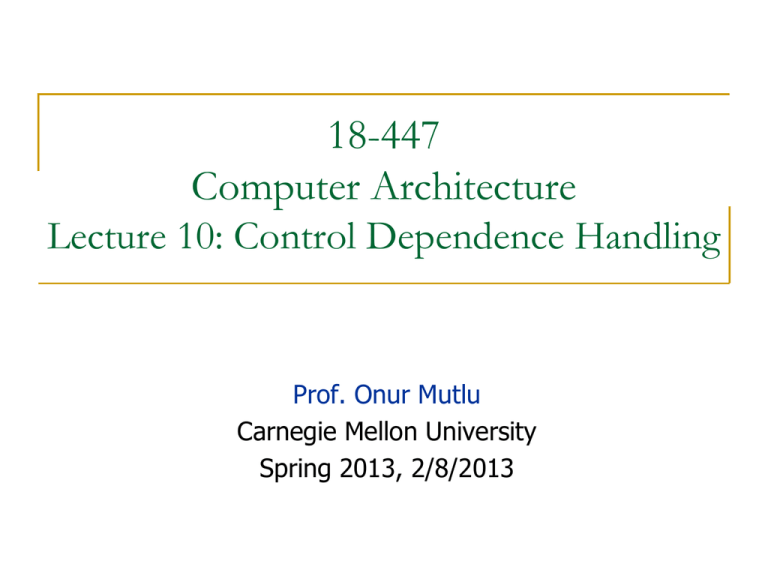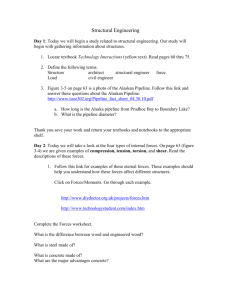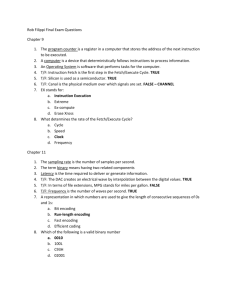
18-447
Computer Architecture
Lecture 10: Control Dependence Handling
Prof. Onur Mutlu
Carnegie Mellon University
Spring 2013, 2/8/2013
Reminder: Homework 2
Homework 2 out
Due February 11 (Monday!)
LC-3b microcode
ISA concepts, ISA vs. microarchitecture, microcoded machines
Remember: Homework 1 solutions were out
2
Reminder: Lab Assignment 2
Lab Assignment 2
Due Feb 15 (next Friday!)
Single-cycle MIPS implementation in Verilog
All labs are individual assignments
No collaboration; please respect the honor code
Do not forget the extra credit portion!
3
Readings for Next Few Lectures
P&H Chapter 4.9-4.11
Smith and Sohi, “The Microarchitecture of Superscalar
Processors,” Proceedings of the IEEE, 1995
More advanced pipelining
Interrupt and exception handling
Out-of-order and superscalar execution concepts
Recommended:
McFarling, “Combining Branch Predictors,” DEC WRL Technical
Report, 1993.
4
Also, …
Kessler, “The Alpha 21264 Microprocessor,” IEEE Micro
1999.
5
Monday: IEEE Tech Talk and CALCM Seminar
Tuesday, February 12, 4:30-6:30pm, Hamerschlag 1107
Dr. Richard E. Kessler, Cavium Fellow and Principal Architect
Designing Efficient Processor Cores for Multicore Networking
Abstract:
The design of CPUs has always required a balance of performance and
efficiency in power, area, and complexity. The emergence of multicore
SoCs armed with accelerators for packet processing has shifted this
balance from solely single-thread performance to a combination of
single-thread performance and efficient parallel processing. This shift
requires a new style of core with short and deterministic pipelines,
caches and memory systems optimized for low latency and high
bandwidth, and an architecture that scales to 48-plus cores on a chip.
This talk demonstrates how continuously emerging application
demands shaped the fundamental principles behind OCTEON processor
cores and supporting on-chip accelerators.
6
Monday: IEEE Tech Talk and CALCM Seminar
Monday, February 11, 4:30-6:30pm, Hamerschlag 1107
Dr. Richard E. Kessler, Cavium Fellow and Principal Architect
Designing Efficient Processor Cores for Multicore Networking
Break-out Session:
Cavium is building a community of university and industry partners around the
32-core OCTEON II solution, with evaluation boards in use by students and
professors at several universities globally. This break-out session for students
will be conducted at the conclusion of the talk above to describe the evaluation
board hardware, the Cavium SDK, and various semester-long student projects
appropriate for upper level undergraduates or first year masters students.
Other aspects of the OCTEON program will be briefly described, including a
multi-university workshop planned in May for students to present their OCTEON
project and compete for the OCTEON Trophy.
7
Last Lecture
Data dependence handling
8
Today’s Agenda
Control dependence handling
9
Review: How to Handle Data Dependences
Anti and output dependences are easier to handle
Dependence on name, not dependence on value/dataflow
Get rid of them via renaming: You have seen a version of this!
Flow dependences are more interesting
Five fundamental ways of handling flow dependences
Detect and wait until value is available in register file
Detect and forward/bypass data to dependent instruction
Detect and eliminate the dependence at the software level
No need for the hardware to detect dependence
Predict the needed value(s), execute “speculatively”, and verify
Do something else (fine-grained multithreading)
No need to detect
10
Questions to Ponder
What is the role of the hardware vs. the software in data
dependence handling?
Software based interlocking
Hardware based interlocking
Who inserts/manages the pipeline bubbles?
Who finds the independent instructions to fill “empty” pipeline
slots?
What are the advantages/disadvantages of each?
11
Questions to Ponder
What is the role of the hardware vs. the software in the
order in which instructions are executed in the pipeline?
Software based instruction scheduling static scheduling
Hardware based instruction scheduling dynamic scheduling
12
More on Software vs. Hardware
Software based scheduling of instructions static scheduling
Compiler orders the instructions, hardware executes them in
that order
Contrast this with dynamic scheduling (in which hardware will
execute instructions out of the compiler-specified order)
How does the compiler know the latency of each instruction?
What information does the compiler not know that makes
static scheduling difficult?
Answer: Anything that is determined at run time
Variable-length operation latency, memory addr, branch direction
How can the compiler alleviate this (i.e., estimate the
unknown)?
Answer: Profiling
13
Control Dependence Handling
14
Control Dependence
Question: What should the fetch PC be in the next cycle?
Answer: The address of the next instruction
If the fetched instruction is a non-control-flow instruction:
Next Fetch PC is the address of the next-sequential instruction
Easy to determine if we know the size of the fetched instruction
If the instruction that is fetched is a control-flow instruction:
All instructions are control dependent on previous ones. Why?
How do we determine the next Fetch PC?
In fact, how do we even know whether or not the fetched
instruction is a control-flow instruction?
15
Branch Types
Type
Direction at
fetch time
Number of
When is next
possible next
fetch address
fetch addresses? resolved?
Conditional
Unknown
2
Execution (register
dependent)
Unconditional
Always taken
1
Decode (PC +
offset)
Call
Always taken
1
Decode (PC +
offset)
Return
Always taken
Many
Execution (register
dependent)
Indirect
Always taken
Many
Execution (register
dependent)
Different branch types can be handled differently
16
How to Handle Control Dependences
Critical to keep the pipeline full with correct sequence of
dynamic instructions.
Potential solutions if the instruction is a control-flow
instruction:
Stall the pipeline until we know the next fetch address
Guess the next fetch address (branch prediction)
Employ delayed branching (branch delay slot)
Do something else (fine-grained multithreading)
Eliminate control-flow instructions (predicated execution)
Fetch from both possible paths (if you know the addresses
of both possible paths) (multipath execution)
17
Stall Fetch Until Next PC is Available: Good Idea?
Insth
Insti
Instj
Instk
Instl
t0
t1
IF
ID
IF
t2
t3
ALU MEM
IF
ID
IF
t4
t5
WB
ALU MEM
IF
ID
IF
WB
ALU
IF
18
This is the case with non-control-flow and unconditional br instructions!
Doing Better than Stalling Fetch …
Rather than waiting for true-dependence on PC to resolve, just
guess nextPC = PC+4 to keep fetching every cycle
Is this a good guess?
What do you lose if you guessed incorrectly?
~20% of the instruction mix is control flow
~50 % of “forward” control flow (i.e., if-then-else) is taken
~90% of “backward” control flow (i.e., loop back) is taken
Overall, typically ~70% taken and ~30% not taken
[Lee and Smith, 1984]
Expect “nextPC = PC+4” ~86% of the time, but what about the
remaining 14%?
19
Guessing NextPC = PC + 4
Always predict the next sequential instruction is the next
instruction to be executed
This is a form of next fetch address prediction and branch
prediction
How can you make this more effective?
Idea: Maximize the chances that the next sequential
instruction is the next instruction to be executed
Software: Lay out the control flow graph such that the “likely
next instruction” is on the not-taken path of a branch
Hardware: ??? (how can you do this in hardware…)
20
Guessing NextPC = PC + 4
How else can you make this more effective?
Idea: Get rid of control flow instructions (or minimize their
occurrence)
How?
1. Get rid of unnecessary control flow instructions
combine predicates (predicate combining)
2. Convert control dependences into data dependences
predicated execution
21
Predicate Combining (not Predicated Execution)
Complex predicates are converted into multiple branches
if ((a == b) && (c < d) && (a > 5000)) { … }
3 conditional branches
Problem: This increases the number of control
dependencies
Idea: Combine predicate operations to feed a single branch
instruction instead of having one branch for each
Predicates stored and operated on using condition registers
A single branch checks the value of the combined predicate
+ Fewer branches in code fewer mipredictions/stalls
-- Possibly unnecessary work
-- If the first predicate is false, no need to compute other predicates
Condition registers exist in IBM RS6000 and the POWER architecture
22
Predicated Execution
Idea: Convert control dependence to data dependence
Suppose we had a Conditional Move instruction…
CMOV condition, R1 R2
R1 = (condition == true) ? R2 : R1
Employed in most modern ISAs (x86, Alpha)
Code example with branches vs. CMOVs
if (a == 5) {b = 4;} else {b = 3;}
CMPEQ condition, a, 5;
CMOV condition, b 4;
CMOV !condition, b 3;
23
Predicated Execution
Eliminates branches enables straight line code (i.e.,
larger basic blocks in code)
Advantages
Always-not-taken prediction works better (no branches)
Compiler has more freedom to optimize code (no branches)
Disadvantages
control flow does not hinder inst. reordering optimizations
code optimizations hindered only by data dependencies
Useless work: some instructions fetched/executed but
discarded (especially bad for easy-to-predict branches)
Requires additional ISA support
Can we eliminate all branches this way?
24
Predicated Execution
We will get back to this…
Some readings (optional):
Allen et al., “Conversion of control dependence to data
dependence,” POPL 1983.
Kim et al., “Wish Branches: Combining Conditional Branching
and Predication for Adaptive Predicated Execution,” MICRO
2005.
25
How to Handle Control Dependences
Critical to keep the pipeline full with correct sequence of
dynamic instructions.
Potential solutions if the instruction is a control-flow
instruction:
Stall the pipeline until we know the next fetch address
Guess the next fetch address (branch prediction)
Employ delayed branching (branch delay slot)
Do something else (fine-grained multithreading)
Eliminate control-flow instructions (predicated execution)
Fetch from both possible paths (if you know the addresses
of both possible paths) (multipath execution)
26
Delayed Branching (I)
Change the semantics of a branch instruction
Idea: Delay the execution of a branch. N instructions (delay
slots) that come after the branch are always executed
regardless of branch direction.
Problem: How do you find instructions to fill the delay
slots?
Branch after N instructions
Branch after N cycles
Branch must be independent of delay slot instructions
Unconditional branch: Easier to find instructions to fill the delay slot
Conditional branch: Condition computation should not depend on
instructions in delay slots difficult to fill the delay slot
27
Delayed Branching (II)
Normal code:
A
Timeline:
if
Delayed branch code:
A
ex
Timeline:
if
ex
A
C
B
BC X
A
B
A
B
A
C
D
C
B
D
BC C
E
BC C
E
B
BC
F
--
BC
F
G
B
X: G
G
--
C
BC X
6 cycles
X:
G
5 cycles
28
Fancy Delayed Branching (III)
Delayed branch with squashing
In SPARC
If the branch falls through (not taken), the delay slot
instruction is not executed
Why could this help?
Normal code:
Delayed branch code:
Delayed branch w/ squashing:
X: A
X: A
A
B
B
X: B
C
C
C
BC X
BC X
BC X
D
NOP
A
E
D
D
E
E
29
Delayed Branching (IV)
Advantages:
+ Keeps the pipeline full with useful instructions in a simple way assuming
1. Number of delay slots == number of instructions to keep the pipeline
full before the branch resolves
2. All delay slots can be filled with useful instructions
Disadvantages:
-- Not easy to fill the delay slots (even with a 2-stage pipeline)
1. Number of delay slots increases with pipeline depth, superscalar
execution width
2. Number of delay slots should be variable with variable latency
operations. Why?
-- Ties ISA semantics to hardware implementation
-- SPARC, MIPS, HP-PA: 1 delay slot
-- What if pipeline implementation changes with the next design?
30
An Aside: Filling the Delay Slot
a . F ro m b e fo re
a dd $ s1 , $ s2 , $ s 3
if $ s 2 = 0 t h e n
reordering data
D e la y s lo t
independent
(RAW, WAW,
WAR)
instructions
does not change B e c o m e s
program semantics
b . F r o m ta rg e t
s u b $ t4 , $ t5 , $ t 6
…
c . F ro m fa ll th ro u g h
a dd $ s1 , $ s2 , $ s 3
if $ s 1 = 0 t h e n
a dd $ s1 , $ s2, $s3
D e la y s lo t
if $ s 1 = 0 th e n
D e la y s lo t
B ecom es
s u b $ t4 , $ t5 , $ t 6
B e co m es
a dd $ s1 , $ s2 , $ s 3
if $ s 1 = 0 t h e n
if $ s 2 = 0 th e n
a dd $s 1 , $ s2 , $ s 3
s u b $ t4 , $ t5 , $ t6
ad d $s 1, $s 2 , $ s3
if $ s 1 = 0 t h e n
Safe?
s u b $ t 4 , $ t5 , $ t6
within same
basic block
[Based on original figure from P&H CO&D, COPYRIGHT
2004 Elsevier. ALL RIGHTS RESERVED.]
a new
instruction
added to nottaken path??
a new
instruction
added to
taken??
31
How to Handle Control Dependences
Critical to keep the pipeline full with correct sequence of
dynamic instructions.
Potential solutions if the instruction is a control-flow
instruction:
Stall the pipeline until we know the next fetch address
Guess the next fetch address (branch prediction)
Employ delayed branching (branch delay slot)
Do something else (fine-grained multithreading)
Eliminate control-flow instructions (predicated execution)
Fetch from both possible paths (if you know the addresses
of both possible paths) (multipath execution)
32
Fine-Grained Multithreading
Idea: Hardware has multiple thread contexts. Each cycle,
fetch engine fetches from a different thread.
By the time the fetched branch/instruction resolves, there is
no need to fetch another instruction from the same thread
Branch/instruction resolution latency overlapped with
execution of other threads’ instructions
+ No logic needed for handling control and
data dependences within a thread
-- Single thread performance suffers
-- Extra logic for keeping thread contexts
-- Does not overlap latency if not enough
threads to cover the whole pipeline
33
Fine-grained Multithreading
Idea: Switch to another thread every cycle such that no two
instructions from the thread are in the pipeline concurrently
Tolerates the control and data dependency latencies by
overlapping the latency with useful work from other threads
Improves pipeline utilization by taking advantage of multiple
threads
Thornton, “Parallel Operation in the Control Data 6600,” AFIPS
1964.
Smith, “A pipelined, shared resource MIMD computer,” ICPP 1978.
34
Fine-grained Multithreading: History
CDC 6600’s peripheral processing unit is fine-grained
multithreaded
Thornton, “Parallel Operation in the Control Data 6600,” AFIPS 1964.
Processor executes a different I/O thread every cycle
An operation from the same thread is executed every 10 cycles
Denelcor HEP (Heterogeneous Element Processor)
Smith, “A pipelined, shared resource MIMD computer,” ICPP 1978.
120 threads/processor
available queue vs. unavailable (waiting) queue for threads
each thread can only have 1 instruction in the processor pipeline; each thread
independent
to each thread, processor looks like a non-pipelined machine
system throughput vs. single thread performance tradeoff
35
Fine-grained Multithreading in HEP
Cycle time: 100ns
8 stages 800 ns to
complete an
instruction
assuming no memory
access
36
Multithreaded Pipeline Example
Slide from Joel Emer
37
Sun Niagara Multithreaded Pipeline
Kongetira et al., “Niagara: A 32-Way Multithreaded Sparc Processor,” IEEE Micro 2005.
38
Fine-grained Multithreading
Advantages
+ No need for dependency checking between instructions
(only one instruction in pipeline from a single thread)
+ No need for branch prediction logic
+ Otherwise-bubble cycles used for executing useful instructions from
different threads
+ Improved system throughput, latency tolerance, utilization
Disadvantages
- Extra hardware complexity: multiple hardware contexts, thread
selection logic
- Reduced single thread performance (one instruction fetched every N
cycles)
- Resource contention between threads in caches and memory
- Some dependency checking logic between threads remains (load/store)
39
How to Handle Control Dependences
Critical to keep the pipeline full with correct sequence of
dynamic instructions.
Potential solutions if the instruction is a control-flow
instruction:
Stall the pipeline until we know the next fetch address
Guess the next fetch address (branch prediction)
Employ delayed branching (branch delay slot)
Do something else (fine-grained multithreading)
Eliminate control-flow instructions (predicated execution)
Fetch from both possible paths (if you know the addresses
of both possible paths) (multipath execution)
40
Branch Prediction: Guess the Next Instruction to Fetch
PC
0x0006
0x0008
0x0007
0x0005
0x0004
??
I-$
0x0001
0x0002
0x0003
0x0004
0x0005
0x0006
0x0007
DEC
RF
WB
LD R1, MEM[R0]
D-$
ADD R2, R2, #1
BRZERO 0x0001
ADD R3, R2, #1
12 cycles
MUL R1, R2, R3
LD R2, MEM[R2]
LD R0, MEM[R2]
Branch prediction
8 cycles
Misprediction Penalty
PC
0x0001
0x0002
0x0003
0x0004
0x0005
0x0006
0x0007
LD R1, MEM[R0]
ADD R2, R2, #1
BRZERO 0x0001
ADD R3, R2, #1
MUL R1, R2, R3
LD R2, MEM[R2]
LD R0, MEM[R2]
I-$
DEC
RF
0x0007
0x0006
0x0005
WB
0x0004
D-$
0x0003
Branch Prediction
Processors are pipelined to increase concurrency
How do we keep the pipeline full in the presence of branches?
Guess the next instruction when a branch is fetched
Requires guessing the direction and target of a branch
A
B1
Branch condition, TARGET
B3
Pipeline
Fetch Decode Rename Schedule RegisterRead Execute
D
E
D
A
F
D
A
F
E B1
E B1
E B1
E B1
F
F
E B1
F
D
A
A
B3
E B1
F
F
D
D
E
A B1
A
E B1
D
E B1
A B1
A
F
D
F
A
D
D
A
A
D
B1
E B1
D
A
A
Verify
the Prediction
What
Target
Misprediction
fetch
Detected!
pipeline
Fetchtofrom
thenext?
correct
target Flush the
F
43
Branch Prediction: Always PC+4
t0
Insth IFPC
Insti
Instj
Instk
Instl
t1
t2
t3
ID
IFPC+4
ALU
ID
IFPC+8
MEM
ALU
ID
IFtarget
Insth is a branch
t4
t5
Insth branch condition and target
evaluated in ALU
When a branch resolves
- branch target (Instk) is fetched
- all instructions fetched since
insth (so called “wrong-path”
44
instructions) must be flushed
Pipeline Flush on a Misprediction
t0
Insth IFPC
Insti
Instj
Instk
Instl
t1
t2
t3
ID
IFPC+4
ALU
ID
IFPC+8
MEM WB
killed
killed
IFtarget ID
IF
Insth is a branch
t4
t5
ALU
ID
IF
WB
ALU
ID
IF
45
Performance Analysis
correct guess no penalty
incorrect guess 2 bubbles
Assume
~86% of the time
no data hazards
20% control flow instructions
70% of control flow instructions are taken
CPI = [ 1 + (0.20*0.7) * 2 ] =
= [ 1 + 0.14 * 2 ] = 1.28
probability of
a wrong guess
penalty for
a wrong guess
Can we reduce either of the two penalty terms?
46
Reducing Branch Misprediction Penalty
Resolve branch condition and target address early
IF .F lu s h
H a z a rd
d e te c tio n
u n it
ID /E X
M
u
x
WB
C o n tro l
0
M
u
x
IF /ID
4
M
WB
EX
M
M E M /W B
WB
S h ift
le ft 2
R e g is te rs
PC
E X /M E M
=
M
u
x
In s tru c tio n
m e m o ry
ALU
M
u
x
D a ta
m e m o ry
M
u
x
Is this a good idea?
S ig n
e x te n d
M
u
x
F o rw a rd in g
u n it
[Based on original figure from P&H CO&D, COPYRIGHT 2004 Elsevier. ALL RIGHTS RESERVED.]
CPI = [ 1 + (0.2*0.7) * 1 ] = 1.14
47
Branch Prediction (Enhanced)
Idea: Predict the next fetch address (to be used in the next
cycle)
Requires three things to be predicted at fetch stage:
Whether the fetched instruction is a branch
(Conditional) branch direction
Branch target address (if taken)
Observation: Target address remains the same for a
conditional direct branch across dynamic instances
Idea: Store the target address from previous instance and access
it with the PC
Called Branch Target Buffer (BTB) or Branch Target Address
Cache
48
Fetch Stage with BTB and Direction Prediction
Direction predictor (2-bit counters)
taken?
PC + inst size
Program
Counter
Next Fetch
Address
hit?
Address of the
current branch
target address
Cache of Target Addresses (BTB: Branch Target Buffer)
Always taken CPI = [ 1 + (0.20*0.3) * 2 ] = 1.12 (70% of branches taken)
49
More Sophisticated Branch Direction Prediction
Which direction earlier
branches went
Direction predictor (2-bit counters)
taken?
Global branch
history
Program
Counter
PC + inst size
XOR
Next Fetch
Address
hit?
Address of the
current branch
target address
Cache of Target Addresses (BTB: Branch Target Buffer)
50
Simple Branch Direction Prediction Schemes
Compile time (static)
Always not taken
Always taken
BTFN (Backward taken, forward not taken)
Profile based (likely direction)
Run time (dynamic)
Last time prediction (single-bit)
51
More Sophisticated Direction Prediction
Compile time (static)
Always not taken
Always taken
BTFN (Backward taken, forward not taken)
Profile based (likely direction)
Program analysis based (likely direction)
Run time (dynamic)
Last time prediction (single-bit)
Two-bit counter based prediction
Two-level prediction (global vs. local)
Hybrid
52





